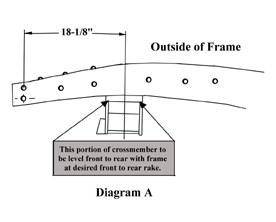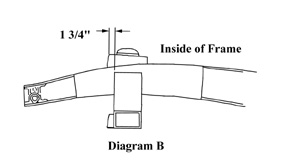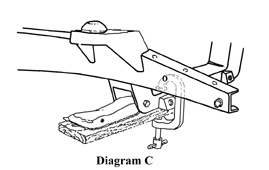 |
Measure back from the center of the
front spring shackle hole in the frame and make a vertical line as shown
in Diagram A. This will be the cantor of the
crossmember and the spindle centerline. Slip the crossmember up into the
frame and center it on the centerline mark. If it doesn't fit in the
frame, grind the sides of the crossmember uprights until you can got it
into position. Make sure that the crossmember is all the way up into the
frame and seated against the underside of the frame rail. Be sure top of
flat portion of crossmember is mounted level front to rear, with frame
at desired front to rear rake. This is important for proper alignment.
You can tack the crossmember into place for now. |
 |
|
Now you can install the
shock towers. The shock towers sit on top of the frame rails
located 1 3/4" forward of the front of the crossmember.
See Diagram B. The taller part of the shock tower is the
front part and should be positioned toward the front of the
vehicle. Fit the shock towers fully against the side of the
frame rails. You can also grind them to fit against the tops
of the rails. Now tack weld the shock towers in place.
|
|
 |
The C-notch for the rack is the last
part to be done. Measure forward 4 5/8" from the centerline and up 1 ½"
and make a mark. Now draw a 2 1/8" radius using your mark as the top of
the radius. See Diagram E. Cut out the material inside the radius
to form the notch leaving 1/8" of material inside the notch for precise
fitting. Try the fit of the C-notch plate. Finish grind the notch for a
good fit and correct location of the C-notch plate. Tack weld the plate
in place. Remove the rack after C- notching both sides of the frame. |
|
|
We do not recommend using strut rods.
Tubular control arms distribute brake load much better. If you choose to
use strut rods - use the following instructions. The lower control arms
and strut rods can be used for locating the strut rod plates and
gussets. Using a 2x4 and a C-clamp, install the control arms as shown in
Diagram C. Install the strut rods onto the control arms. Assemble
onto the strut rod ends the large rubber bushings, including the cupped
washers, and strut rod plates. Align the tops of the plates with the
underside of the frame rails, then fully tighten the nuts on the strut
rods to their fully seated position. See Diagram D. The Pinto and
Mustang strut rods are different lengths. We recommend the Pinto strut
rods, as they are shorter and will position the strut rod plates more
closely to the underside of the frame rails. The Mustang strut rods can
be used, however, by heating the rod at the bend at the ball joint end
and bending out enough to align the strut plates to the bottom of the
frame. The strut rods will act as alignment fixtures while you tack weld
the plates in place, then tack weld the gussets in place also. See
Diagram E. Now you can remove the strut rods and control arms |
|
|
| Now you are
finished with the crossmember assembly. Install the rest of the
front end. When the rest of the car is complete you can use the
following information to align your front suspension: |
| |
|
| With vehicle
weight and at ride height specifications are: |
| Camber: 0
degrees Caster: 1 - 1-1/2 degree positive, Toe in 1/16" for
radial tires or 1/8" for bias ply tires. |
| |
|
| Please note -
It may take 100 or more miles of driving for the springs to
fully settle to ride height. They may settle 3/4" - 1" |
|